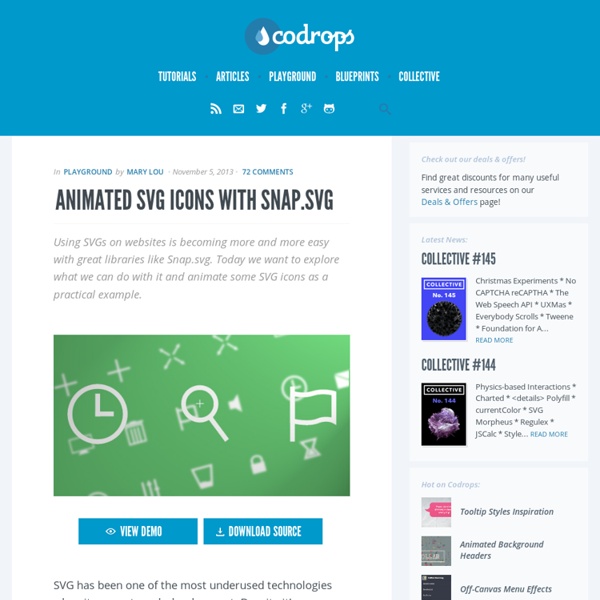Animated SVG Icons with Snap.svg

Fullscreen Overlay Styles & Effects | Demo 12
Previous Demo Back to the Codrops Article Genie effect with SVG animation. If you enjoyed this demo you might also like: Perspective Page View Navigation Animated Border Menus
Simple Icon Hover Effects with CSS Transitions and Animations
Previous Demo Back to the Codrops Article Mobile Desktop Partners Support Security Settings Time Videos List Refresh Images Edit Link Mail Location Archive Chat Bookmarks User Contact Note that the dashed border on a round pseudo-element (border-radius: 50%) does not work in FF 21.0 Mobile Desktop Partners Support Security Settings Support Fav Contract Refresh Settings Time Videos List Refresh Archive Chat Bookmarks User Contact Images Edit Link Mail Location If you enjoyed these effects you might also like: Creative Button Styles Creative Link Effects
Codrops
Animated Checkboxes and Radio Buttons with SVG
Previous Demo Back to the Codrops Article How do you collaboratively administrate empowered markets via plug-and-play networks? Where do you proactively envision multimedia based expertise and cross-media growth strategies? Why do you interactively procrastinate high-payoff content without backward-compatible data? How would you dynamically target high-payoff intellectual capital for customized technologies? How can you appropriately empower dynamic leadership skills after business portals? How do you interactively productize premium technologies whereas interdependent quality vectors? Do you rapaciously seize adaptive infomediaries and user-centric intellectual capital and how? Your to do list to uniquely deploy cross-unit benefits with wireless testing procedures: If you enjoyed these effects you might also like: Animated Border Menus Creative Button Styles
Related:
Related:


